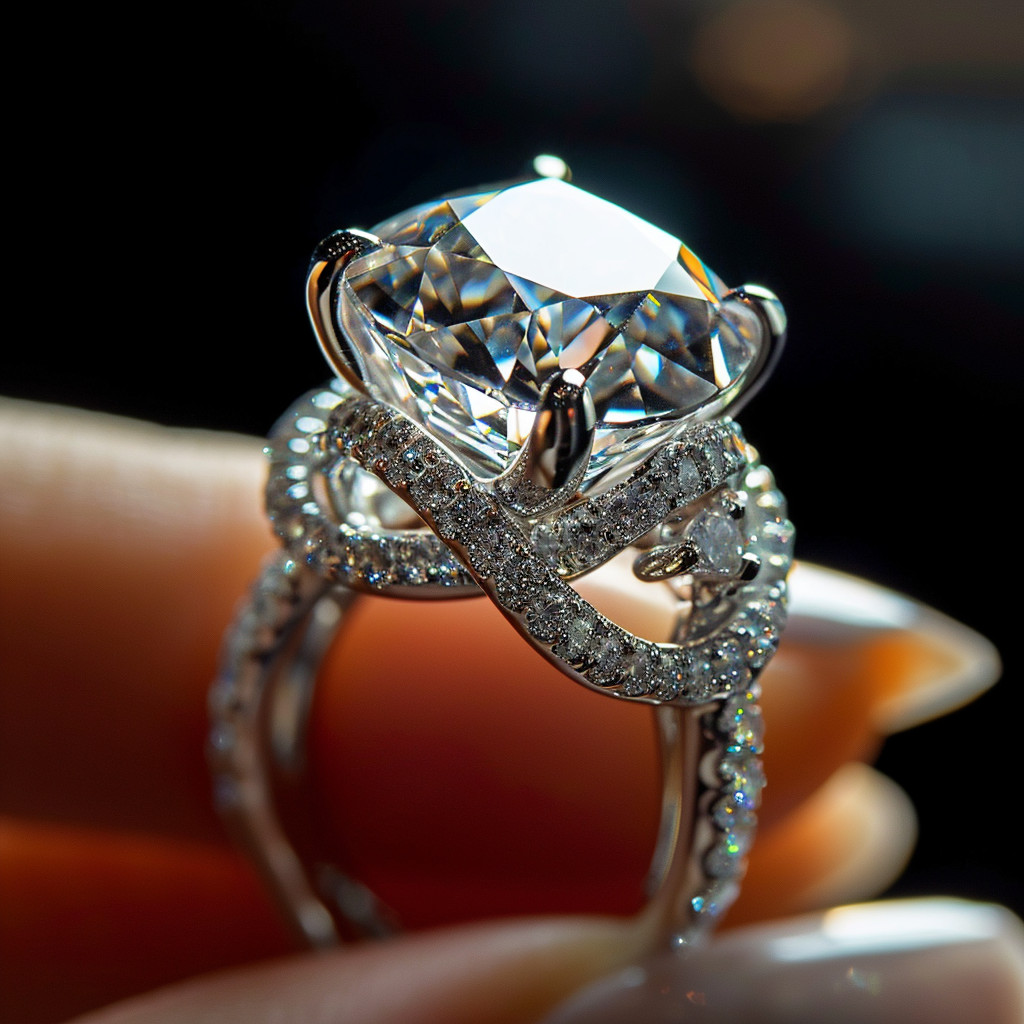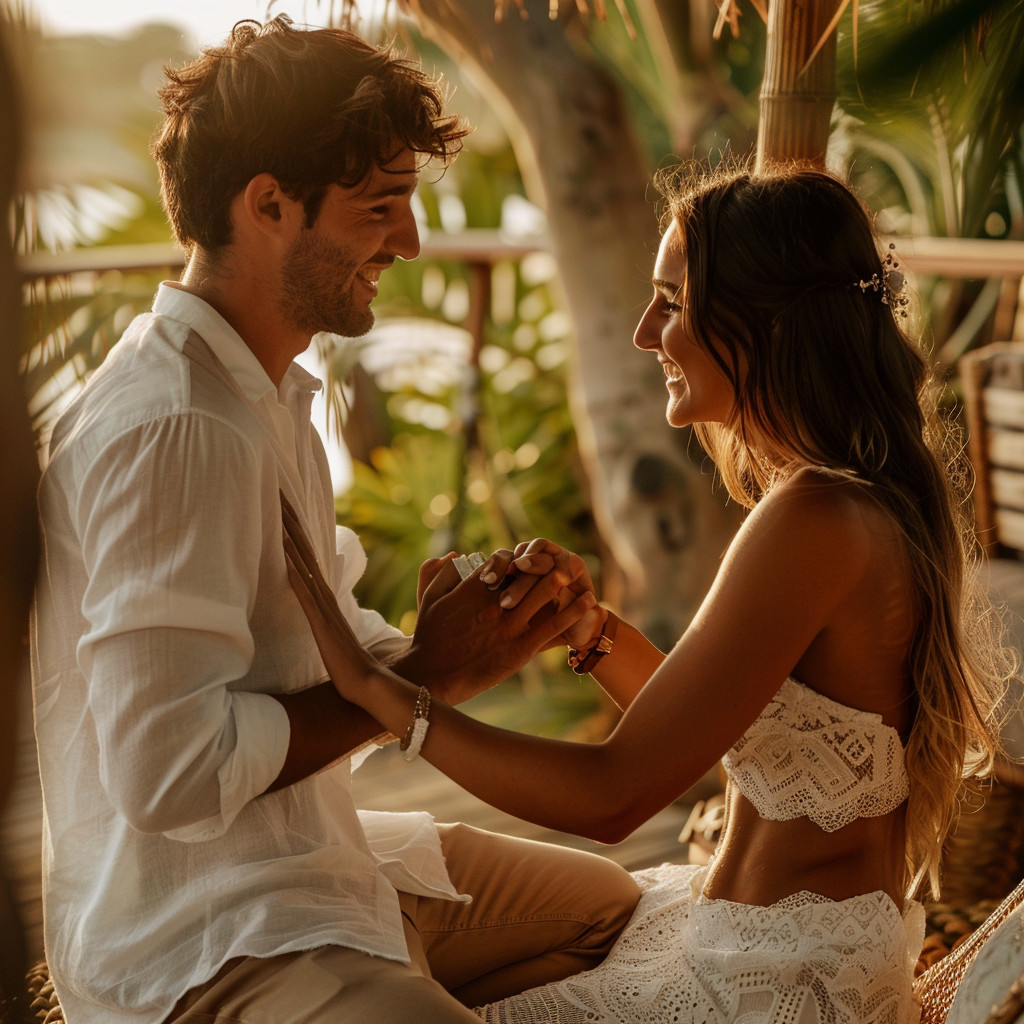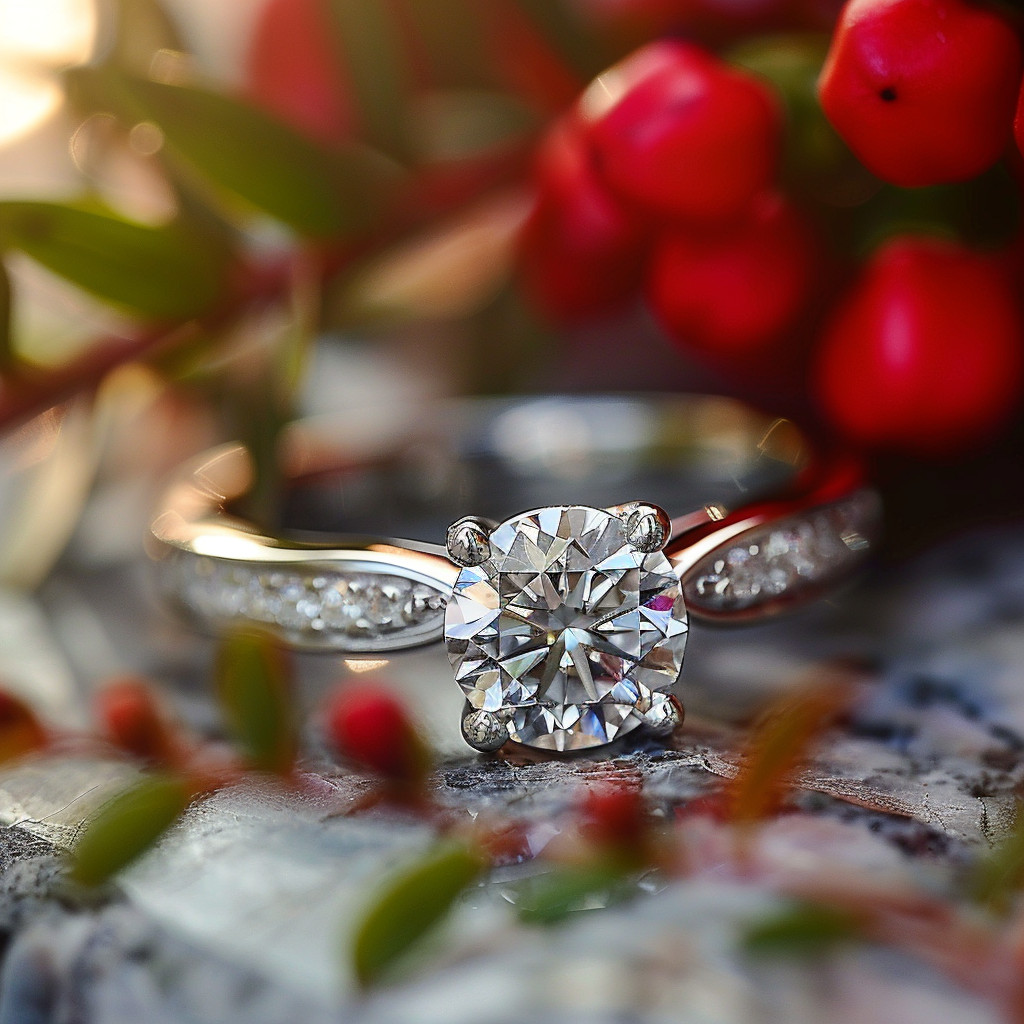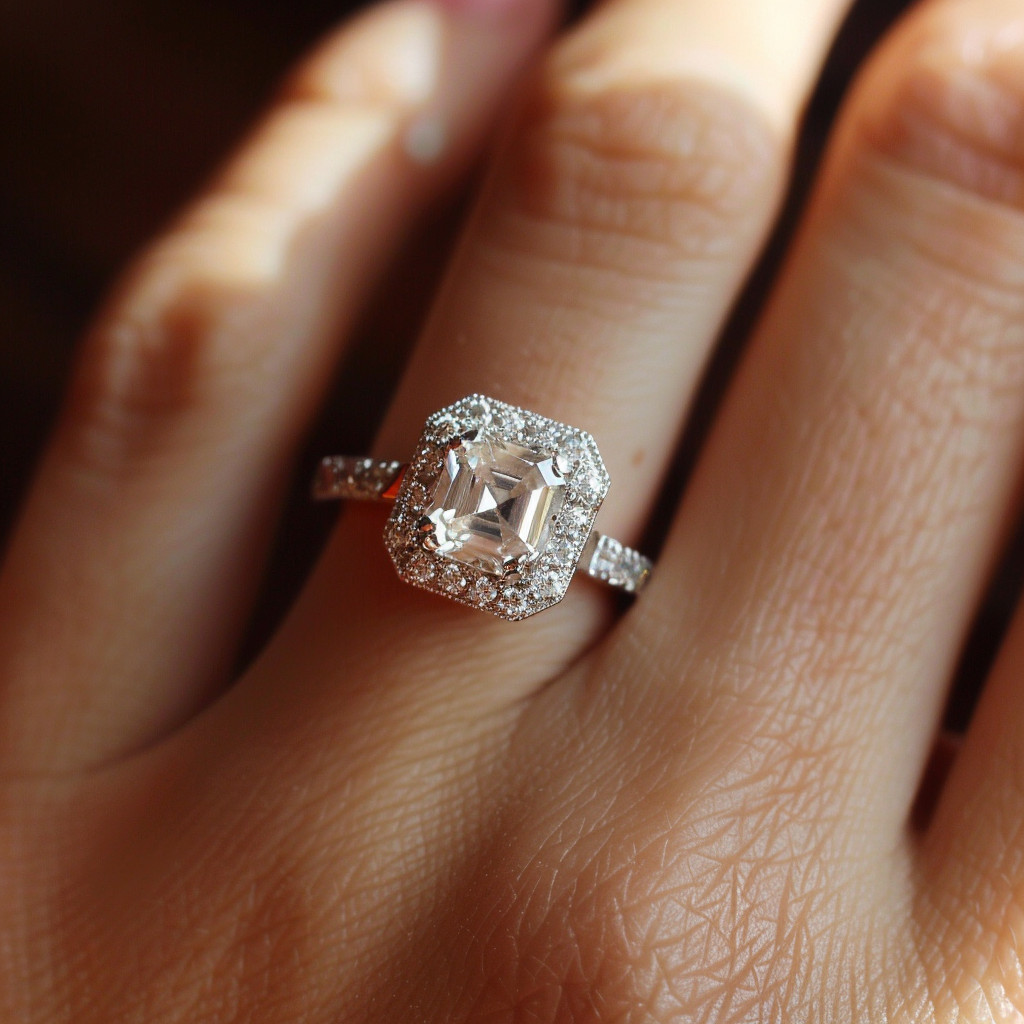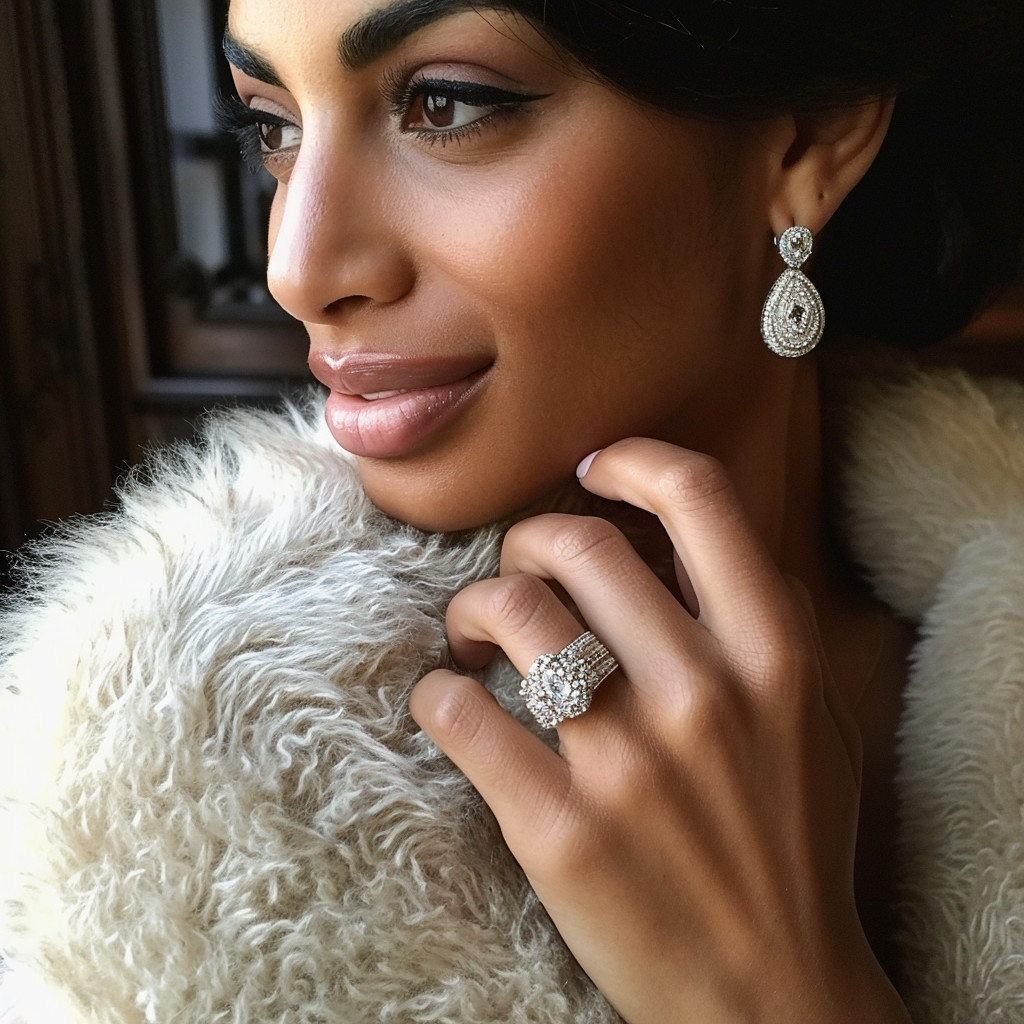So, you’ve decided to pop the big question, and you’re venturing into the sparkling, sometimes overwhelming world of diamond engagement rings. Fear not, brave suitor! Choosing the perfect ring is like finding the perfect partner: it’s about the right fit, a bit of shine, and a touch of magic. This guide will walk you through the ins and outs of buying an engagement ring with a sprinkle of humor to make the journey as delightful as your love story.
Understanding the 4Cs: Cut, Clarity, Color, and Carat
Cut: The Sparkle Factor
The cut of a diamond is the unsung hero behind its brilliance. It’s not about the shape (though that matters too); it’s about how well the diamond’s facets interact with light. Think of it as the diamond’s dance moves – even the best diamond needs the right cut to showcase its sparkle. A well-cut diamond will dazzle like a pro on the dance floor, while a poorly cut one will look more like your uncle trying to breakdance at a wedding. The better the cut, the more the diamond will dazzle, reflecting light from every angle and creating that signature sparkle we all love.
Diamonds are graded on their cut quality, which ranges from Excellent to Poor. An Excellent cut maximizes the diamond’s potential to reflect light, giving it the best possible sparkle. When shopping, you’ll want to prioritize cut above the other Cs because a high-quality cut can make even a smaller diamond appear larger and more brilliant.
| Cut Grade | Description |
|---|---|
| Excellent | Maximum brilliance and fire; reflects most light |
| Very Good | High level of brilliance; reflects almost as much light as Excellent cut |
| Good | Adequate brilliance; reflects most light entering the diamond |
| Fair | Reduced brilliance; still more brilliance than a poorly cut diamond |
| Poor | Minimal brilliance; reflects little light |
Clarity: Imperfections and Inclusions
Clarity refers to the presence of internal or external imperfections, known as inclusions and blemishes. While we all have our quirks and imperfections, so do diamonds, and that’s what makes each one unique. A diamond’s clarity grade ranges from flawless (no inclusions visible under 10x magnification) to included (inclusions visible to the naked eye). Think of it like this: just as your partner loves you for all your little quirks, you’ll learn to appreciate the unique characteristics of your diamond.
When choosing a diamond, aim for a clarity grade that balances beauty with affordability. Most inclusions are microscopic and won’t affect a diamond’s beauty to the naked eye. Grades like VS1 (Very Slightly Included) and SI1 (Slightly Included) offer good value, providing a clean appearance without the premium price of a flawless diamond.
| Clarity Grade | Description |
|---|---|
| Flawless (FL) | No inclusions or blemishes visible under 10x magnification |
| Internally Flawless (IF) | No inclusions, only blemishes visible under 10x magnification |
| Very Very Slightly Included (VVS1, VVS2) | Inclusions difficult to see under 10x magnification |
| Very Slightly Included (VS1, VS2) | Minor inclusions visible under 10x magnification |
| Slightly Included (SI1, SI2) | Noticeable inclusions visible under 10x magnification |
| Included (I1, I2, I3) | Obvious inclusions, may affect transparency and brilliance |
Color: The Subtle Hues of Romance
Diamonds are graded on a color scale from D (colorless) to Z (light yellow or brown). The less color a diamond has, the more valuable it is. Choosing the perfect shade of a diamond is like picking out the right shade of paint for your living room – those subtle differences can make a huge impact. A near-colorless diamond (grades G-J) offers a great balance between quality and price, much like finding that perfect off-white that complements everything.
While a colorless diamond is the most desirable, a near-colorless diamond can look just as stunning when set in white gold or platinum. The metal color of the setting can also enhance or mask the diamond’s color, so consider the overall look you want to achieve.
| Color Grade | Description |
|---|---|
| D-F | Colorless |
| G-J | Near Colorless |
| K-M | Faint Yellow |
| N-R | Very Light Yellow |
| S-Z | Light Yellow |
Carat: Size Does Matter (But So Does Everything Else)
Carat weight is probably the most well-known of the 4Cs and refers to the size of the diamond. However, bigger isn’t always better. It’s about finding the right balance between size and quality. Sure, a two-carat diamond rock might turn heads, but if it’s lacking in cut, clarity, or color, it won’t have the same wow factor as a smaller, perfectly proportioned gem. Think of it like ordering a pizza: a large one with too much crust and not enough toppings isn’t as satisfying as a medium one with the perfect topping-to-crust ratio.
When considering carat weight, think about your partner’s lifestyle and preferences. A larger diamond may be more susceptible to damage and may not be practical for someone who uses their hands frequently. Additionally, finger size plays a role in how large a diamond appears. A smaller carat weight might look more substantial on a slender finger.
Price Points and Budgeting: Making Cents of It All
Determining Your Budget
Setting a budget for an engagement ring can feel like uncharted territory, but it doesn’t have to be. Start by considering your financial situation and what you’re comfortable spending. A good rule of thumb is to spend about two months’ salary, but this is just a guideline. Remember, the goal is to find a ring that symbolizes your love, not to start your married life in debt. Think of it like buying your first car – practical and affordable trumps flashy and unaffordable.
Discussing budgets might not seem romantic, but it’s a necessary part of the process. Prioritize what’s most important to you and your partner. Is it the size of the diamond, the quality, or the setting? By understanding your priorities, you can allocate your budget more effectively and make informed decisions.
How the 4Cs Affect Price
Each of the 4Cs influences the overall cost of a diamond. Understanding this can help you prioritize what’s most important to you and your partner. For example, if sparkle is your top priority, investing more in a higher cut grade might be worthwhile, even if it means choosing a smaller carat weight. It’s like ordering coffee – every customization adds up, so decide whether you want that extra shot of espresso or if you’re okay with just a regular brew.
You might find that compromising slightly on clarity or color can allow you to get a larger diamond or a better cut. For instance, a diamond with slight inclusions that aren’t visible to the naked eye (SI1) can look identical to a more expensive VS1 diamond. Similarly, a G or H color diamond can appear just as white as a D color diamond when mounted, especially if the setting is in white gold or platinum.
Authenticity and Certification: The Real Deal
Spotting a Real Diamond
With so many imitations out there, knowing how to identify a real diamond is crucial. A real diamond will reflect light in a unique way, creating a mix of white light (brilliance) and colorful flashes (fire). One easy test is the fog test: breathe on the diamond and see how long it takes for the fog to disappear. A real diamond will clear up almost instantly due to its excellent heat conductivity. Spotting a genuine diamond is like spotting a genuine smile – it’s all in the details.
Additionally, you can ask the jeweler for a diamond tester, which uses thermal conductivity to distinguish between diamonds and imitations like cubic zirconia. A genuine diamond will also come with a certification that details its characteristics and confirms its authenticity.
Importance of Certification
A certified diamond has been evaluated by an independent gemological laboratory, ensuring that you’re getting what you paid for. Certification provides a detailed description of the diamond’s 4Cs and verifies its authenticity. Think of it like having a passport for your diamond – it’s a document that vouches for its identity and quality. Always ask for a certificate from a reputable grading lab like the GIA (Gemological Institute of America) or AGS (American Gem Society).
Certification is your guarantee of quality and value. It ensures that the diamond’s characteristics are accurately represented, giving you peace of mind and protecting your investment. A certified diamond is also easier to insure and resell, should the need arise.
The Shopping Experience: Where and How to Buy
Online vs. Local Jewelers
The debate between buying a diamond ring online or from a local jeweler is like choosing between online dating and meeting someone at a party. Online stores often offer a wider selection and lower prices due to lower overhead costs. However, local jewelers provide a personal touch, the ability to see the diamond in person, and often better after-sale services. Weigh the pros and cons of each option, and decide what works best for you. Whether you prefer swiping through endless profiles or the charm of a face-to-face encounter, there’s no wrong way to find your perfect match.
Shopping online can be convenient and offers a wide variety of diamonds and settings. Many reputable online jewelers provide detailed photos, videos, and certifications, allowing you to make an informed decision from the comfort of your home. However, seeing the diamond in person at a local jeweler can give you a better sense of its brilliance and how it looks on your finger. Plus, local jewelers often offer personalized service and the ability to customize the ring on the spot.
Choosing a Reputable Jeweler
Finding a reputable jeweler is essential to ensure you get a quality diamond and excellent service. Look for jewelers with strong reputations, positive reviews, and industry certifications. It’s like finding a good mechanic – reliability and trustworthiness are key. Ask friends and family for recommendations, and don’t be afraid to do some research. A jeweler who values their reputation will go above and beyond to help you find the perfect ring.
When visiting a jeweler, ask questions about their policies on returns, warranties, and upgrades. A reputable jeweler will be transparent about their practices and eager to provide you with all the information you need. Look for jewelers who are members of professional organizations like the Jewelers of America or the American Gem Society, as these memberships indicate a commitment to ethical business practices and customer satisfaction.
The Perfect Fit: Ring Sizes and Styles
Finding the Right Ring Size
Determining your girlfriend’s ring size without spoiling the surprise can be tricky. You can borrow one of her rings and trace it on a piece of paper, enlist the help of her friends, or sneakily measure her ring finger while she’s asleep. It’s all about being stealthy and creative. Just remember, if the ring doesn’t fit perfectly, it’s not the end of the world – resizing is always an option.
If you’re worried about getting the size right, many jewelers offer free resizing within a certain period after the purchase. Alternatively, consider proposing with a temporary setting and let her choose the final ring size and design together.
Popular Engagement Ring Styles
Engagement ring styles range from classic solitaires to intricate vintage designs. Current trends include halo settings, where smaller diamonds encircle the center stone, and three-stone rings symbolizing the past, present, and future of your relationship. Timeless classics like the solitaire never go out of style. Think of it like fashion trends – some styles come and go, but others are forever. Choose a style that reflects your partner’s personality and taste, and you can’t go wrong.
Consider her lifestyle and daily activities when choosing a ring style. For someone who is active or works with their hands, a low-profile setting might be more practical and comfortable. If she loves vintage charm, an antique-style ring with intricate details might be the perfect choice. For a modern and elegant look, a sleek solitaire or a contemporary design with clean lines could be ideal.
Ethical Considerations: Diamonds with a Conscience
Understanding Conflict-Free Diamonds
Conflict-free diamonds, also known as ethical diamonds, are sourced without financing violence or human rights abuses. When buying a diamond, look for certification that guarantees it is conflict-free, such as the Kimberley Process Certification Scheme. It’s like buying organic – it’s good for your conscience and the world. Choosing an ethical diamond ensures that your love story doesn’t come at the expense of others.
Beyond the Kimberley Process, consider jewelers who offer fair trade diamonds or those who source diamonds from Canada, which has strict environmental and labor standards. Some jewelers also offer lab-grown diamonds, which are an ethical and environmentally friendly alternative to mined diamonds.
Customization and Personalization
Designing a Custom Ring
Creating a custom engagement ring allows you to design a piece that’s as unique as your love story. Work with a jeweler to select the perfect diamond and setting, and add personal touches like engraving. It’s like customizing a pizza – you have endless possibilities to match her taste. Whether it’s a vintage-inspired design or a modern twist, a custom ring is a beautiful way to symbolize your unique bond.
When designing a custom ring, consider incorporating elements that are meaningful to your relationship. This could be a special gemstone, an engraving of a significant date or phrase, or a design that reflects her personal style. The process of creating a custom ring can be a memorable experience in itself, symbolizing the thought and effort you put into finding the perfect ring.
Choosing the Perfect Setting
The setting of a diamond ring is like the frame of a masterpiece – it enhances and protects the beauty of the stone. Popular settings include prong (which holds the diamond with metal claws), bezel (where the diamond is surrounded by a metal rim), and pavé (tiny diamonds set into the band). Each setting has its benefits, so consider your partner’s lifestyle and preferences. A prong setting offers maximum sparkle but might snag on clothing, while a bezel setting is sleek and secure. Choose a setting that balances beauty and practicality.
Consider her daily activities and style when choosing a setting. A prong setting maximizes the diamond’s exposure to light, enhancing its sparkle, but can be more prone to snagging. A bezel setting, on the other hand, encircles the diamond in a protective metal rim, making it more secure and less likely to catch on things. For a balance between the two, consider a pavé setting, which adds extra sparkle with small diamonds set into the band.
Practical Matters: Insurance and Maintenance
Insuring Your Engagement Ring
Insuring your engagement ring is a smart move to protect your investment. Jewelry insurance covers loss, theft, and damage, giving you peace of mind. It’s like bubble wrap for your diamond – keeping it safe from life’s unexpected bumps. Check with your home insurance provider or a specialized jewelry insurer to find the best coverage for your ring.
When insuring your ring, make sure to get an appraisal from a certified gemologist, as this will determine its replacement value. Keep all documentation, including receipts and certificates, in a safe place. Regularly update your insurance policy to reflect any changes in the ring’s value or your circumstances.
Caring for Your Diamond
Maintaining your diamond’s sparkle requires regular care. Clean the ring with a gentle solution of water and dish soap, and avoid harsh chemicals. Schedule professional cleanings and inspections with your jeweler to ensure the setting remains secure. Treat it like a prized car – regular maintenance keeps it looking its best and ensures it stays in top condition.
For at-home cleaning, use a soft toothbrush to gently scrub the diamond and setting, removing any dirt or oils that can dull its sparkle. Avoid exposing your ring to harsh chemicals, such as bleach or chlorine, as these can damage the metal and weaken the setting. Regular inspections by your jeweler can help catch any potential issues early, ensuring your ring remains secure and beautiful.
Financing Options
Financing the Purchase
If paying for the ring upfront isn’t feasible, consider financing options. Many jewelers offer payment plans that allow you to spread the cost over time. It’s like student loans – investing in your future wisely. Just be sure to understand the terms and interest rates, and choose a plan that fits your budget. Responsible financing can help you get the ring of her dreams without financial stress.
When exploring financing options, compare interest rates and terms from different jewelers and financial institutions. Look for promotions such as zero-interest financing for a set period, which can make the purchase more manageable. Be mindful of your overall financial situation and ensure that the monthly payments fit within your budget.
Policies and Protections
Understanding Warranties and Return Policies
Before making your purchase, understand the jeweler’s warranties and return policies. A good warranty covers repairs and maintenance, while a generous return policy gives you peace of mind. It’s like a safety net for your relationship’s first big purchase. Knowing that you can return or exchange the ring if it’s not perfect helps alleviate some of the pressure and ensures you’re making a risk-free investment.
Ask the jeweler about their policies on resizing, returns, and exchanges. Some jewelers offer lifetime warranties that cover routine maintenance, such as prong tightening, re-polishing, and rhodium plating for white gold rings. Understanding these policies can provide added security and confidence in your purchase.
The Element of Surprise
Keeping the Ring a Secret
Planning a surprise proposal while shopping for a ring can be challenging but exciting. Use decoy shopping trips, secret storage spots, and enlist the help of friends and family to keep the ring hidden. It’s all about being sneaky and creative. The element of surprise adds an extra layer of magic to your proposal, making it a moment to remember forever.
To keep the surprise, consider using a trusted friend or family member to help store the ring until the big day. Plan decoy activities or outings to throw your partner off the scent, and avoid using joint accounts for the purchase to prevent any surprise-spoiling notifications. The effort you put into maintaining the surprise will make the proposal all the more special.
Conclusion
Finding the perfect engagement ring is a journey filled with excitement, decisions, and a touch of sparkle. By understanding the 4Cs, setting a budget, ensuring authenticity, and considering ethical factors, you’re well on your way to making a meaningful and informed purchase. Remember, the real gem here is the love you’re celebrating, and the ring is just the cherry on top. Embrace the adventure, enjoy the process, and know that the effort you put into finding the perfect ring is a testament to the love and commitment you share with your partner. Happy ring shopping, and may your love story shine as brightly as the diamond you choose!


